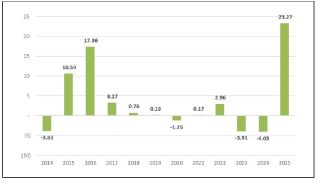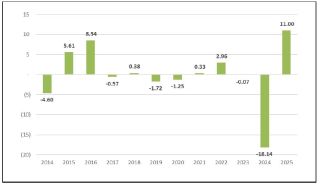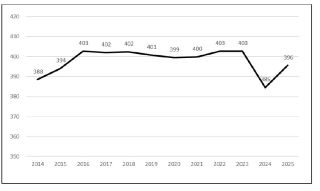The Rich-Poor and Middle-Poor Gap

In addition to tracking the post-Budget income levels of different households, Social Justice Ireland is also focused on assessing how the income divides between different household types have changed following the adoption of Budgetary policies. Taking such an approach offers valuable insights into some of the short-term and medium-term trends in income inequality. Again, there is merit in undertaking this analysis over multiple years so that the cumulative effect of budgetary policies is captured. To achieve this, we track the following two gaps: the Rich-Poor gap and the Middle-Poor gap. This year, following the conclusion of the term of the coalition Government elected in 2020 (2020-2025), we also include an assessment of the overall impact on these income gaps of budgetary policy adopted across the period of office of that Government.
The Rich-Poor gap
This gap monitors the income of single individuals on jobseekers’ benefit (‘poor’) and the disposable income (after income taxation and employee social insurance) of a single PAYE worker earning €100,000 (‘rich’). An annual income of €100,000 is chosen as representing very high-income earners given:
- how uncommon this income level is in Irish society (the top 180,000 earners representing 6.5 per cent of all earners in 2021 according to the Revenue Commissioners); and
- how it represents approximately twice average earnings.
The analysis tracks both the change to this gap each year (see chart 3) and the overall size of this gap following the most recent Budget (see chart 4). The analysis covers the period from Budget 2014 to the most recent measures.
Chart 3: Budget-by-Budget Change in the Weekly Rich-Poor Gap, 2014-2025

Source: Social Justice Ireland Income Distribution Model. Notes: The analysis presents the measures as announced in each annual Budget including temporary supports for that budgetary year. 2025 measures include welfare & income taxation changes announced for 2025 plus the electricity credit planned for early 2025.
Chart 4: The Rich-Poor Gap, 2014-2025 (€ per week)

Source: Social Justice Ireland Income Distribution Model. Notes: See notes to Chart 3.
As a result of all the taxation, welfare and one-off temporary measures adopted in Budget 2025, the rich-poor gap increased by €23 per week (€1,214 per annum) in 2025. After that Budget the cumulative rich-poor gap stood at €990 per week (almost €52,000 per annum). The large change in 2025 has been driven by the end of most cost-of-living temporary supports for lower income households and the significant income taxation decreases received by well-off households in Budget 2025.
Looking across the entire period examined, the rich-poor gap has grown by a total of €49 per week (€2,575 per annum) over the period 2014-2025. Although the gap decreased as a result of some cost-of-living supports in recent years (2023 and 2024), in 2025 the rich-poor gap will climb to its highest level since our analysis commenced.
The Middle-Poor gap
This gap monitors the income of single individuals on jobseekers’ benefit (‘poor’) and the disposable income (after income taxation and employee social insurance) of a single PAYE worker earning €40,000 (‘middle’). This middle-income figure approximated average earnings which stood at €40,283 in 2019 according to the CSO and is not dissimilar to the latest value for median earnings of €43,221 (CSO for 2023). The analysis tracks both the change to this gap each year (see chart 5) and the overall size of this gap following the most recent budget (see chart 6). The analysis covers the period from Budget 2014 to the most recent Budget.
As a result of all the taxation, welfare and one-off temporary measures adopted in Budget 2025, the middle-poor gap grew by €11 per week (€574 per year). The change in the gap in 2025 has been driven by the end of most cost-of-living temporary supports for lower income households and income taxation changes (to tax credits and USC rates and bands) which exceeded the value of the weekly change in welfare payments.
Chart 5: Budget-by-Budget Change in the Weekly Middle-Poor Gap, 2014-2025

Source: Social Justice Ireland Income Distribution Model. Notes: This analysis tracks the annual disposable income change in the gap between single jobseekers and PAYE earners on €40,000 per annum. See also notes to Chart 3.
Chart 6: The Middle-Poor Gap, 2014-2025 (€ per week)

Source: Social Justice Ireland Income Distribution Model. Notes: See notes to Chart 5.
The cumulative middle-poor gap stood at €396 per week (€20,639 per annum) in 2025. Looking across the entire period examined (2014-2025), the middle-poor gap has increased by €7 per week (€369 per annum). Although the gap decreased for the first time in over a decade as a result of the temporary income supports provided in 2024, these temporary measures are not currently scheduled to repeat beyond early 2025 and the expectation is that this gap is likely to grow further.
Income Gaps and the 2020-2025 Coalition Government
Budget 2025 marked the fifth and final Budget of the coalition Government that held office from 2020-2025. Therefore, this year edition of this document offers an opportunity to review the overall impact of that Governments policy choices on these income gaps. As different policy priorities can be articulated for each Budget and policy initiative, it is useful to bring together the cumulative effect of all these policy changes on various household types across whole period.
Based on our analysis we find:
- Over the period from 2020-2025, the rich-poor gap widened by €18.45 per week (€963 per annum) meaning the gap between those with the highest incomes and those on the lowest has widened as a result of policy choices.
- Over the period from 2020-2025, the middle-poor gap decreased (by €3.92 per week, €204 per annum); an outcome driven by the skewed nature of income tax reduction choices which prioritised higher earners and provided relatively little to low income workers paying income tax at the standard rate over those years.
Overall, our results suggest that budgetary policy over recent years has reduced the gap between people/households of working age in the bottom and middle of the income distribution while opening a greater gap between them and those with the highest incomes. Social Justice Ireland regrets that policy outcome, as a society we can ill afford to see the incomes of those with the most resources drift further away.